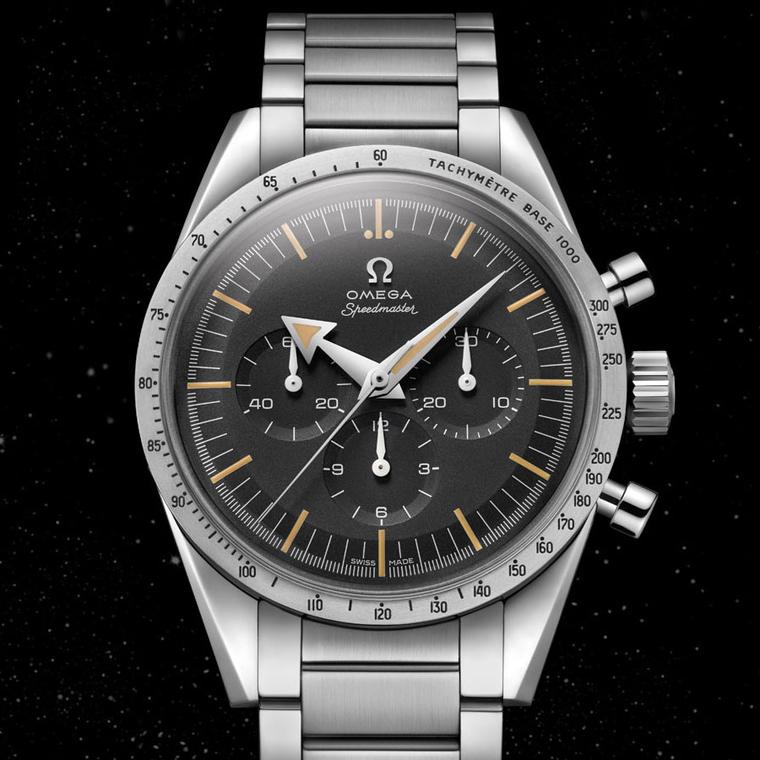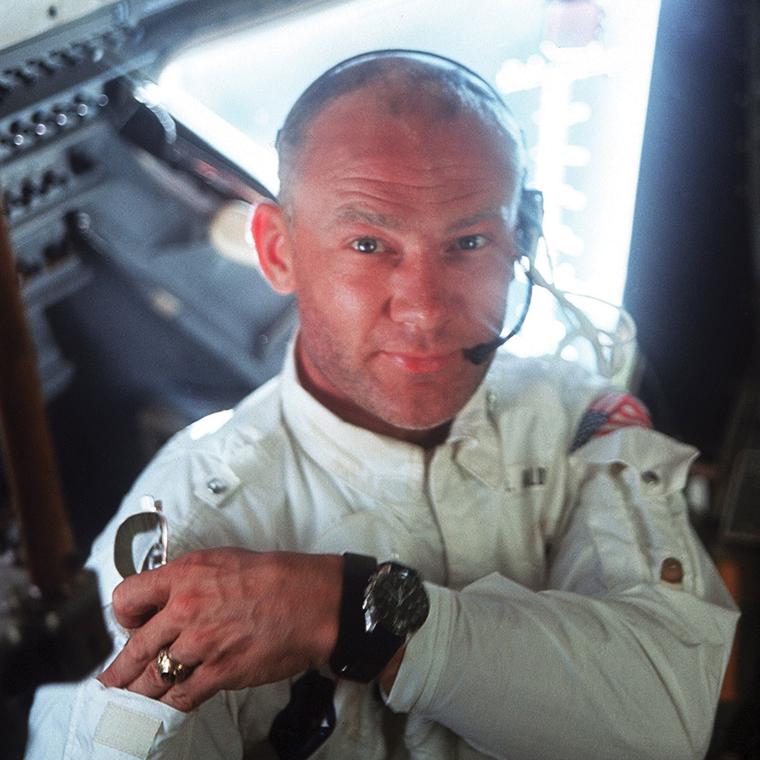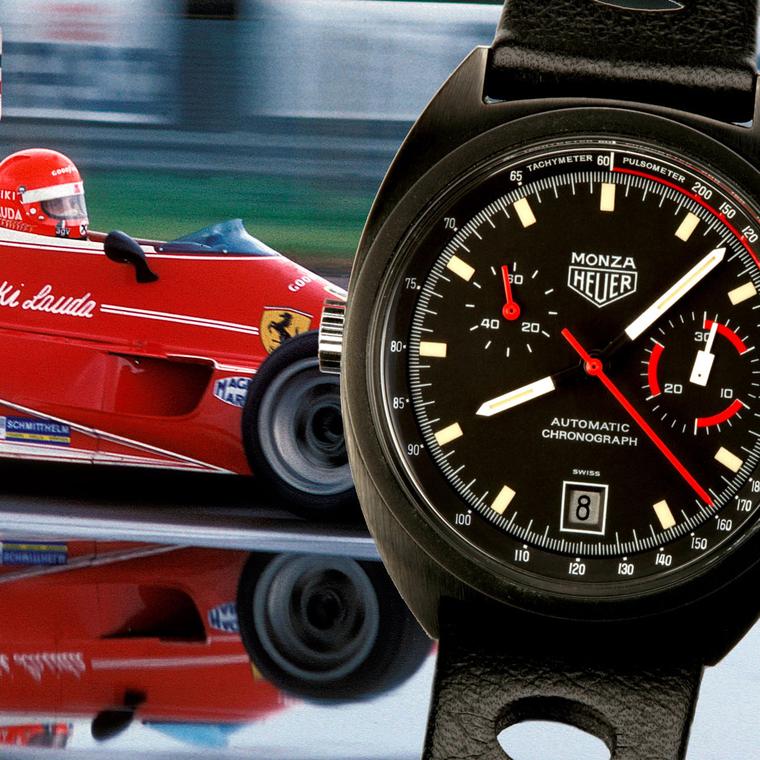
If we can talk about celebrities in the watch world, Omega’s Speedmaster takes the cake. Celebrating its 60th anniversary of uninterrupted life on Earth, and 48 years since it first landed on the Moon, the Speedmaster has not lost an inch of its gravitational pull since it was spotted on Buzz Aldrin’s wrist in the epic Moon landing of July 1969. With an unmatched record of six Moon landings, the Speedmaster has been on every manned US space flight, making this timepiece a veritable hero of horological and space history.
The birth of an icon
Launched by Omega in 1957, the Speedmaster was the first chronograph to display a tachymeter scale on the bezel, setting an aesthetic benchmark in the realm of chronographs that has yet to wane. Designed to measure elapsed times and speed with chronograph and tachymeter functions, the Speedmaster was one of three professional watches launched by the Swiss brand – along with the Seamaster and the Railmaster – offering a high-precision, water-resistant watch that was easy to read and use.
Celebrating six decades of success, Omega has launched an anniversary edition of the Speedmaster that pays great respect to the original 1957 model. To capture the iconic spirit of its ancestor, the 2017 model features Broad Arrow hands, a black tropical dial, vintage-style beige SuperLuminova and the original manual-winding calibre 1861, the same one that accompanied American astronauts to the Moon and back.
The Space Race
In 1958, NASA started its foray into manned space exploration, pitting the USA and the USSR in a technological and patriotic duel to conquer space. President John F. Kennedy aimed even higher and in his address to Congress in 1961 said: “I believe that this nation should commit itself to achieving the goal, before this decade is out, of landing a man on the Moon and returning him safely to the Earth. No single space project in this period will be more impressive to mankind, or more important for the long-range exploration of space.”

Maiden voyage in zero gravity
Omega’s ‘unofficial’ maiden voyage into space occurred in 1962 on board Walter Schirra’s wrist during the Mercury programme orbital flights. The CK 2998 Speedmaster worn by Schirra on board the Sigma 7 in 1962 was, in fact, his personal watch, back when astronauts were not kitted out with official timepieces by NASA.
All this would change in 1964 following a petition by astronauts for backup timing devices on their missions. Flight Crew Operations Director, Deke Slayton, issued an internal memo asking for “a highly durable and accurate chronograph to be used by Gemini and Apollo flight crews”, and the wheels were set in motion for a series of tests to select a winning candidate for the job.
Tested to survive destruction
According to James H. Ragan, retired NASA Project Engineer and author of the section on Speedmaster and NASA in Moonwatch Only – the most extensive recounting of the Moonwatch’s evolution over the past 60 years – the trials were “designed literally to test the watches to destruction”. Exposing the timepieces to massive oscillations in temperature, from 93ºC to -18ºC, violent shocks of 40 g’s, high and low pressure, humidity, a corrosive oxygen environment, noise and vibrations, the only watch to endure the torture was Omega’s Speedmaster.

Declared “Flight Qualified for all Manned Space Missions” by NASA, the Speedmaster made its first official trip into space on 23 March 1965, on the wrists of Virgil Grissom and John Young during the Gemini III mission and again on 3 June on America’s first spacewalk, executed by astronaut Edward White. To fit over the astronauts’ thickly padded suits, the steel bracelet of the Speedmaster was exchanged for a long Velcro strap.
After a faultless performance in space, the Speedmaster was ready for the Apollo 11 mission that would effectively end the Space Race and substantiate President Kennedy’s ambitious goal of landing a man on the Moon.

The Eagle has landed
The Apollo 11 blasted off on 16 July 1969 from the Kennedy Space Centre in Florida. Four days later, Commander Neil Armstrong and pilot Buzz Aldrin landed the Eagle lunar module on the surface of the Moon, in the Sea of Tranquillity, while Michael Collins remained in orbit in the command module Columbia. Glued to their televisions, 600 million viewers on Earth watched Armstrong descend the ladder of the lunar module and heard him utter the immortal words: “One small step for man, one giant leap for mankind.”
Joining Armstrong on the surface of the Moon about 20 minutes later, Aldrin was in awe of the virgin lunar terrain, which he described as a “magnificent desolation”. But they were not alone. Strapped to Aldrin’s spacesuit was the rugged and reliable Speedmaster, which from this epic day in 1969 would become known as the ‘Moonwatch’.

Houston, we’ve had a problem here
During the troubled Apollo 13 mission of 1970, Omega’s Speedmaster watch proved to be a lifesaver. Following the explosion of a reserve oxygen tank, which damaged the electronic timekeeping mechanisms on board, Commander James Lovell used his mechanical manual-winding Speedmaster Chronograph to time the critical firing of the re-entry rockets, allowing for the safe return of his crew to planet Earth. In recognition of the crucial role that the Speedmaster chronograph played on the Apollo 13 mission, Omega received the “Snoopy" Award in October 1970 – the highest honour awarded by NASA astronauts.

Diplomacy in zero gravity
The Speedmaster was also witness to another moment of enormous geopolitical symbolism. During the 1975 Apollo-Soyuz mission, when the Apollo rocket docked with the Soviet Union’s Soyuz in space for a handshake, American astronauts were delighted to discover that the Soviet cosmonauts were also wearing Speedmaster chronographs. With the advent of the Space Shuttle programme in 1978, the Speedmaster was selected as the official watch and in 1984 accompanied Bruce McCandless on his space scooter, marking the first untethered spacewalk.

A faithful companion to astronauts more than 50 years after it was first worn in space, it is hard to think of a watch with a more exciting and valiant career than Omega’s Speedmaster. Revisited throughout its 60 years of life, owning a Speedmaster Moonwatch is a reminder of that unforgettable day in 1969 when two men and a Speedmaster took their first step on the Moon, thus writing one of the most exciting chapters in 20th-century history.






















